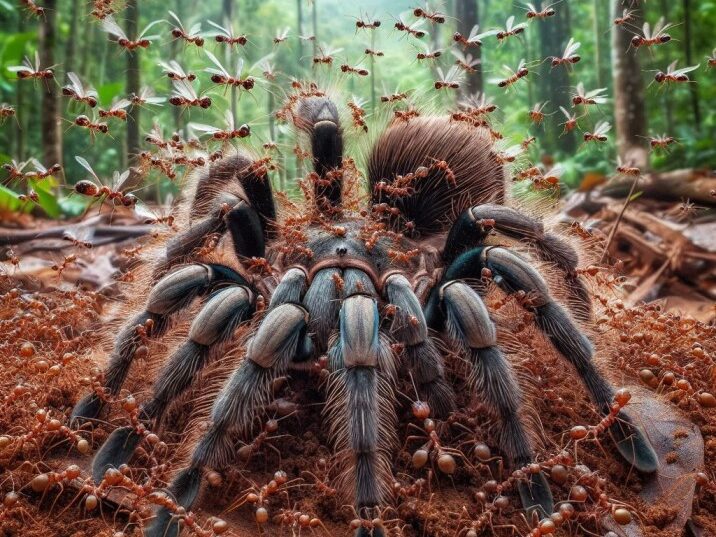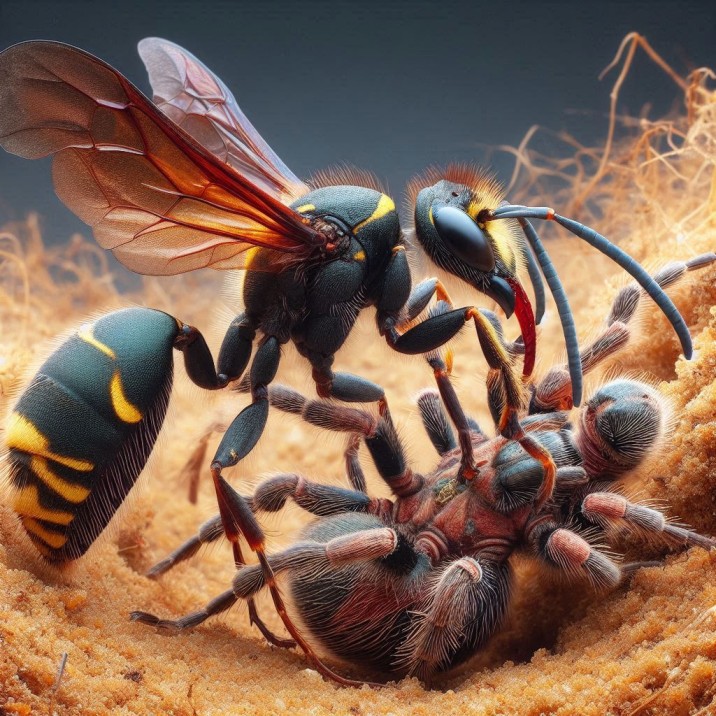Introduction
Table of Contents
Tarantulas are among the most fearsome predators in the insect world. With their large, hairy bodies and venomous fangs, they strike fear into the hearts of many creatures. But did you know that even a mighty tarantula has natural enemies? Some insects are surprisingly capable of taking on a tarantula and even winning the battle. In this article, we’ll explore what insects can beat a tarantula, revealing the fascinating world of predator-prey relationships in the insect kingdom. Whether you’re a budding scientist or just curious about nature, this article will take you on a thrilling journey of discovery!

Table of Information: what insects can beat a Tarantula
| Insect | Habitat | Unique Ability | Tarantula Interaction | Outcome |
|---|---|---|---|---|
| Spider Wasp | Deserts, Forests | Paralyzing Sting | Preys on tarantulas | Often victorious |
| Centipede | Tropical regions | Venomous Bite | Predatory encounters | Depends on size |
| Praying Mantis | Gardens, Forests | Swift Strikes | Rare but possible | Varies, often mutual |
| Ants (Army Ants) | Tropical Forests | Swarm Attack | Overwhelm with numbers | Can overpower tarantulas |
| Assassin Bug | Various habitats | Piercing Mouthpart | Ambush predator | Can be fatal for tarantula |
What Insects can Beat a Tarantula?
To answer this question What Insects can beat a Tarantula, there is following list of insects that can kill a tarantula:
1. The Spider Wasp: A Deadly Rival
The spider wasp is perhaps the most well-known insect that can beat a tarantula. This incredible insect is specialized in hunting spiders, particularly large tarantulas. Spider wasps are found in various habitats, including deserts and forests, and they are equipped with a powerful paralyzing sting.
How Does the Spider Wasp Defeat a Tarantula?
The process is both fascinating and gruesome. The wasp will first locate a tarantula’s burrow and lure it out. Once the tarantula is in the open, the wasp delivers a precise sting, paralyzing the tarantula but keeping it alive. The wasp then drags the immobilized tarantula to a burrow where it lays an egg on the spider’s body. When the wasp larva hatches, it feeds on the tarantula, eventually killing it.
2. Centipedes: Venomous Predators
Centipedes are another formidable rival for tarantulas. Found primarily in tropical regions, these long, segmented insects are known for their speed and venomous bite. Unlike most insects, centipedes are agile hunters capable of taking down large prey.
How Do Centipedes Challenge Tarantulas?
Centipedes often encounter tarantulas in the wild, and the outcome of such encounters depends on the size of both predators. Large centipedes have been known to bite and kill tarantulas by injecting venom that incapacitates the spider. However, if the tarantula is larger, it may overpower the centipede.
3. Praying Mantis: A Swift Striker
The praying mantis is known for its quick reflexes and predatory behavior. Although they are not common predators of tarantulas, certain species of mantis may occasionally engage in a fight with a spider.
How Do Praying Mantises Interact with Tarantulas?
In a rare encounter, a praying mantis may attempt to strike at a tarantula with its sharp, spiked forelegs. If the mantis lands a blow, it can seriously injure the tarantula. However, these encounters are rare, and often both creatures will avoid each other.
4. Army Ants: Strength in Numbers
While an individual ant is no match for a tarantula, army ants rely on sheer numbers to overpower their prey. These ants are found in tropical forests, and they are known for their coordinated swarm attacks.
How Do Army Ants Overcome a Tarantula?
Army ants can overwhelm a tarantula by attacking it from all sides. They use their powerful jaws to bite and tear at the tarantula’s body, often leading to the spider’s death. The ants then carry pieces of the tarantula back to their colony.
5. Assassin Bugs: Stealthy Killers
Assassin bugs are named for their lethal hunting techniques. These insects are ambush predators, using their piercing mouthparts to inject venom into their prey, including tarantulas.
How Do Assassin Bugs Prey on Tarantulas?
An assassin bug will wait for the right moment to strike a tarantula, delivering a venomous bite that liquefies the spider’s insides. The bug then feeds on the tarantula, leaving only the exoskeleton behind.
Conclusion
While tarantulas are often seen as fearsome predators, they are not invincible. Insects like the spider wasp, centipede, praying mantis, army ants, and assassin bugs can all potentially beat a tarantula in a battle. These fascinating encounters highlight the incredible diversity of the insect world and the complex relationships between predators and prey. Understanding these interactions helps us appreciate the delicate balance of nature and the remarkable survival strategies of these creatures.
FAQs about What Insects can Beat a Tarantula
- Can a spider wasp really kill a tarantula?
- Yes, a spider wasp can paralyze and eventually kill a tarantula by laying an egg on it.
- Are centipedes more dangerous to tarantulas?
- Centipedes can be dangerous to tarantulas, especially if they are of a similar size or larger.
- Do praying mantises often attack tarantulas?
- No, praying mantises rarely attack tarantulas, but it can happen under specific circumstances.
- How do army ants manage to kill a tarantula?
- Army ants rely on their numbers, swarming and biting the tarantula until it succumbs.
- What makes assassin bugs so deadly to tarantulas?
- Assassin bugs use their piercing mouthparts to inject venom that liquefies the tarantula’s insides, making them particularly deadly.

